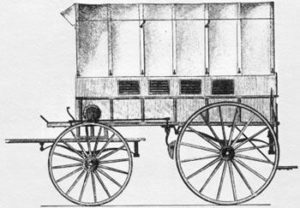
Although this is a drawing of an Army ambulance, the early circus wagons were very similar. The high wheels allowed the wagons to cross streams travel muddy roads much easier.
One fall day in 1857 a stranger rode into Greenville to pass out handbills telling everyone about the circus coming in a few days. He also spread the word around the small village for those who were unable to read, and then rode on to Paris.
What excitement he created! No circus had ever performed in Greenville. Everyone scrapped up enough money, actually a few cents, to attend. On Saturday morning the town was full of people. Since it was a very small town it didn’t take a crowd to fill up the streets.
The circus was to arrive from McKinney on what is now Washington Street, the major thoroughfare from east to west. Noon came and went. Speculation was the circus would be in town by three or four to perform before dark. Boys and men rode out on the McKinney road to wait. Someone would rush into town to alert townspeople when the circus people were spotted.
About four o’clock the first wagon arrived, but somehow they had lost the other wagon. Now, it is necessary to explain circus wagons and their cargo. These were not like the Conestoga that brought thousands of pioneers westward. They were more like ambulances the Army used. Something like a square box placed on two axles pulled by a team of oxen. One of the circus performers sat on a bench in front of the box to drive the team. Curtains of duck cloth hung from the sides of the box, allowing protection from rain and a breeze in the summer. No one was inside the wagon, only props, the circus tent, posts and other circus accouterments. All performers who doubled as crew walked along side the two wagons.
But one of the wagons was missing. As soon as the circus people arrived in town, they told how the second wagon made a wrong turn somewhere. Surely they would be in town shortly.
The road to McKinney was fraught with mishaps. There are numerous creeks between the two towns. No paved or even cleared roads crossed those creeks. Transportation depended upon livestock trails, first used by wild animals and Native Americans. Finally about dark, the second wagon arrived.
Determined not to disappoint the citizens, and to collect admission fees, the circus tent quickly went up. Flares made of large branches provided light. The crowds quickly gathered inside to see the amazing feats of the circus performers. Suddenly a storm came up out of the northwest, high winds blew down the tent and ended the circus performance. Thankfully no one was injured.
The Ring Master announced that the performance would continue the next morning, free of charge. Even though it was a Sunday morning, the church at Shady Grove postponed services. Even more people attended the circus, the first to be held in Greenville or Hunt County.
Circus people continued to entertain in Greenville for many years. Occasionally one now comes in the spring. Transportation has changed from ambulance wagons, to railroads, to trucks today. No animals, except the oxen, accompanied the earliest circuses. But still, young children and a few adults are thrilled by the circus. Entertainment was hard to come by in 1857.
